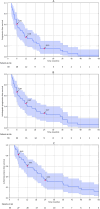Local control and recurrence patterns after stereotactic irradiation delivered in more than 4 fractions for hepatocellular carcinomas and liver metastases: a retrospective study
- PMID: 39915761
- PMCID: PMC11804025
- DOI: 10.1186/s13014-025-02595-x
Local control and recurrence patterns after stereotactic irradiation delivered in more than 4 fractions for hepatocellular carcinomas and liver metastases: a retrospective study
Abstract
Background: Stereotactic Body Radiation Therapy (SBRT) is a safe and effective treatment for liver metastases or hepatocellular carcinoma (HCC) with a dose-response relationship for local control (LC). Proximity to organs at risk (OAR) often requires dose de-escalation. This study evaluated LC and recurrence patterns in patients administered hepatic SBRT in more than 4 fractions due to dosimetric constraints.
Methods: This retrospective study included 33 patients treated with SBRT (Cyberknife®) in more than 4 fractions for HCC or liver metastases, between January 2011 and December 2019. Patients were ineligible for treatment in 3 or 4 fractions due to OAR proximity. Recurrence patterns were analysed according to the volume shared between recurrence and initial target or treatment isodose volumes.
Results: The primary dose ranged from 35 to 50 Gy delivered in 5 to 7 fractions for the treatment of HCC (39%) or liver metastases (61%) mainly secondary to colorectal cancer (40%). LC rate was 64%, with 12 patients showing recurrence volume overlap with the initial target volume or treatment isodose. In-field recurrence occurred in only 12.5% of patients with most relapses being out-of-field. No grade ≥ 3 events were reported.
Conclusion: Despite dose reductions to spare OAR, SBRT showed satisfactory LC with low toxicity. Out-of-field recurrence remains the most common pattern identified and likely related to underlying disease. Prospective data are necessary to determine whether preserving dose while reducing planning target volume (PTV) coverage could enhance LC. Trial registration All patients were retrospectively registered, and this study is registered at the Health Data Hub site (number HDH414).
Keywords: Dosimetric constraints; Hepatocellular carcinoma; Liver metastases; Local control; SBRT.
© 2025. The Author(s).
Conflict of interest statement
Declarations. Ethics approval and consent to participate: This study was approved by the National Commission for Information Technology and Civil Liberties (CNIL) and registered with the French data protection authority. Clinical trial number: Not applicable. Consent to Participate: Not applicable. Competing interests: The authors declare no competing interests.
Figures


References
-
- Durand-Labrunie J, Baumann AS, Ayav A, Laurent V, Boleslawski E, Cattan S, et al. Curative irradiation treatment of hepatocellular carcinoma: a multicenter phase 2 trial. Int J Radiat Oncol Biol Phys. 2020;107(1):116–25. - PubMed
-
- Vogel A, Cervantes A, Chau I, Daniele B, Llovet JM, Meyer T, et al. Hepatocellular carcinoma: ESMO clinical practice guidelines for diagnosis, treatment and follow-up. Ann Oncol. 2018;29:238–55. - PubMed
-
- Benson AB, D’Angelica MI, Abbott DE, Anaya DA, Anders R, Are C, et al. Hepatobiliary cancers, version 2. 2021, NCCN clinical practice guidelines in oncology. J Natl Compr Canc Netw. 2021;19(5):541–65. - PubMed
MeSH terms
LinkOut - more resources
Full Text Sources
Medical

